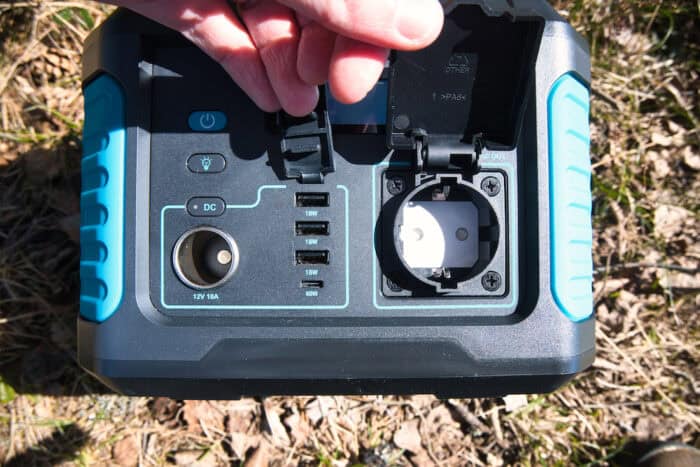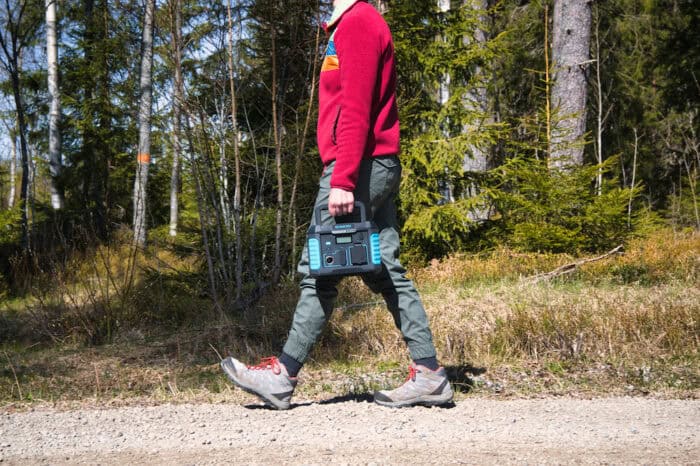The Rugged Romoss RS500 Is Ready For The Outdoors
Today I’ll be reviewing the Romoss RS500, which is a portable entry-level power station.

At first glance, it may look like every other power station, but there are a couple of features that make it stick out.
Let’s not waste any time and get right to the specifications.
Romoss RS500 Specifications
Battery Capacity
The lithium battery has a 400Wh capacity. It uses Li-Ion batteries.
With a 400Wh battery, it can power a 50W device for almost 7 hours (with an 85% inverter efficiency).
Power Inverter
The AC inverter is rated at 500W, with a peak of 1000W.
That means that the AC port can output up to 1000W but only for a short period of time. It can, however, output 500W steadily until the battery is depleted.
A 500W inverter is powerful enough to run small kitchen appliances and tools, laptops, tablets, TVs, gaming consoles, most desktop computers, and similar devices.
I could power my small toaster with it. According to the display on the power station, it used 450 watts.
Ports
All the ports are on the front of the power station.
Every port but the 12V DC port is protected to prevent dust and debris from entering and damaging them.
There is a single AC outlet, three USB A ports, one USB C port, and one 12V cigarette lighter plug.

I received the EU model, which is why it has a 220V outlet. If you purchase it in the US, you’ll get one with a 110V outlet.
The three USB A ports can output up to 18W, while the USB C can output up to 60W.
If you have a 12V fridge or fan, you’ll plug it into the regulated 12V cigarette plug, which is rated for up to 10A (120W).
The power station and its ports are turned on with buttons.
- Power button – Turns on and off the power station.
- DC button – Turns on and off the USB and 12V ports.
- AC button – Turns on and off the inverter, i.e. the AC outlet.
- Eco button – Turns on and off the eco mode. When on, the power station will automatically go to sleep after a period of time, it’s unclear after how long. When off, the ports will stay on until the battery is depleted, even if nothing is connected to them.
- Flashlight button – Turns on and off LED lights, more on this under “other features” below.
Charging
Like most power stations, it can be charged in several ways.

There is a single 8mm port on the front, so you can’t use the car charger and solar panels at the same time.
- AC wall charger – The included wall charger recharges the battery from 0 to 100% in four hours.
- Car charger – The included car charger can recharge the battery in 7-9 hours.
- Solar panels – Romoss does not include solar panels or a solar adapter, but the power station is ready for solar panels thanks to its built-in MPPT solar charge controller. It can handle panels rated between 12-28V, up to 100W. That means it takes at least four hours to charge the battery with solar panels. Make sure your panel does not have a charge controller.
If you have a 12V solar panel with MC4 connectors, it should plug directly into the Romoss RS500 with an MC4 to 8mm adapter (click to view on Amazon).
Display
The display on the front tells you everything you need to know.
Input/output watts, battery percentage and bars, active ports, hours/minutes to empty/full, and temperature warnings.
Other Features
One thing that stood out to me is the silicone “bumpers”. There is one on each corner to protect the case.
There is a 10W wireless charger on top of the power station.
It’s a Qi-charger, so it’s compatible with all devices that use that standard. I have used it to charge my iPhone and Airpods, and it works great.
A built-in handle on top that folds up and down makes it easy to carry and transport the battery. It’s robust and stays in any position you put it.
Last but not least, it has built-in LED lights. One on the side, and one on the folding handle.

These lights are controlled with the flashlight-button. One push turns on the side LED, two turns on the handle LED, three turns off both.
Holding the button for two seconds enables the SOS-mode, which makes the side LED flash.
In The Box
Romoss includes a wall and car charger.
Size And Weight
It weighs 9.5 lb (4.3 kg) and measures 9.1 by 6.6 by 7 inches (23 by 17 by 18 cm).
My Review
Like
Compact and portable for its capacity
When I unboxed the RS500, I thought I got sent the 300Wh version. But it wasn’t wrong, it’s just that the RS500 is very compact and portable.
I don’t think you can make a 400Wh power station with these features any smaller.

Protected, powerful ports
I often wonder why the manufacturers of these power stations don’t consider how their products are going to be used.
They’re often used outdoors where things quickly get dusty, and one easy way to protect a power station from dust and debris is by protecting the ports.
This power station has covers in front of the AC and USB ports, so it’s already better than a lot of its competitors.
The ports are also relatively powerful.
Light in handle
I haven’t seen it before, but I would like to see it more. The LED on the handle makes sense, and it’s actually useful.
The problem with flashlights on most power stations is that they’re not adjustable. Since it’s in the handle on the RS500, you can adjust the angle of the light.
Is it better than having a regular flashlight? Of course not, but it makes it the best flashlight implementation I have seen on a power station.
Don’t Like
Only one AC outlet
I know I am always asking for more ports, but it bothers me when a power station with a 500W inverter only has one AC outlet.
Sure, there isn’t really any space for it, but it’s something I don’t like.
No charging via USB C
I think it’s great that the USB C port can output up to 60W since that lets me quickly charge my laptop and phone, but it would’ve been great if it could handle input as well.
That would’ve made it possible to charge the battery in more than one way at a time, and reduced the number of cables to bring on a trip.
No app support
There is no way to monitor and control it with your phone.
Conclusion
The is a good power station.
It’s great for charging and powering your devices on the go, and I recommend it to both full-time travelers and the photographer heading out camping for the weekend.

For more information about the RS500, check out Romoss’ website.
If you’re not sure the 400Wh battery will be enough, I recommend buying a solar panel for it.
A lot of portable panels include 8mm connectors, and those are compatible right out of the box with the RS500. An example of a panel like that is the RoRood 100W panel (click to view on Amazon).
Please leave a comment down below if you have questions.

